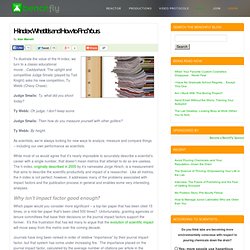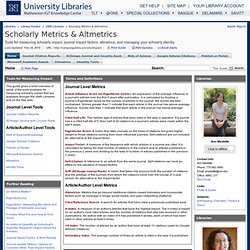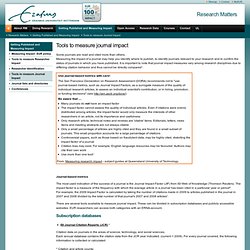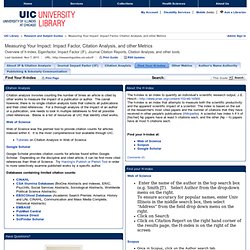

Article, author and journal metrics: what librarians need to know. How librarians are raising researchers’ reputations: An exploration of academic networks, profiles and analysis With the continued extension of the academic research enterprise – both locally and globally – librarians are being asked to support researchers and the research organization with new services.

Learn how three librarians from leading institutions are implementing data, tools and strategies to advance their researchers and strengthen their organizations' research mission during a free Library Connect webinar. Presenters: CHRIS ERDMANN, Head Librarian, John G. Wolbach Library and Information Resource Center, Harvard-Smithsonian Center for Astrophysics HEATHER CHISHOLM, Programme Manager for Collaboration and Student Centric Streams, Information Technology and Service Department, Imperial College London Registration is required for this live 50-minute webcast.
Measuring Your Impact - Measuring Your Impact: Impact Factor, Citation Analysis, and other Metrics - Research and Subject Guides at University of Illinois at Chicago. MyRI Homepage. H-index. H-Index: What It Is and How to Find Yours. To illustrate the value of the H-index, we turn to a classic educational movie…Caddyshack.

The uptight and competitive Judge Smails (played by Ted Knight) asks his new competition, Ty Webb (Chevy Chase): Judge Smails: Ty, what did you shoot today? Ty Webb: Oh judge, I don’t keep score. Judge Smails: Then how do you measure yourself with other golfers? Ty Webb: By height. As scientists, we’re always looking for new ways to analyze, measure and compare things – including our own performance as scientists. While most of us would agree that it’s nearly impossible to accurately describe a scientist’s career with a single number, that doesn’t mean metrics that attempt to do so are useless. Why isn’t impact factor good enough? Which paper would you consider more significant – a top-tier paper that has been cited 15 times, or a mid-tier paper that’s been cited 500 times?
What is the H-index? The index is a measure of the number of highly impactful papers a scientist has published. Figure 1. Figure 2. Bibliometrics. Bibliometrics refers to the various ways that exist of measuring influence or impact in the journal literature.

Well known metrics include impact factor, h-index and citation counts. Publications cited on this page and a number of documents related to bibliometrics can be found in the Bibliometrics collection at Mendeley. To learn more about the metrics listed below, and the types of tools you can use to access and calculate metrics, use the in-depth tutorial freely available from the Irish National Digital Learning Resources repository.
Web of Science Times cited – to find out if an individual article has been cited, click on the number next to Times cited to get a list of articles citing the article you have viewed.Cited reference search – this can be done to get a total citation count for an author or for a specific work (journal article, book, etc.). This is often more thorough than times cited count.H-index – developed by J.E. Bibliometrics. Home - Scholarly Metrics & Altmetrics - Library Guides at University of Nevada, Reno. Use more than one tool.

No database indexes all journals or all issues of journals, and some will include publication formats (dissertations, blog posts, book chapters, conference papers, etc.) that are not covered in other databases Be aware of where the data comes from for any tools you use. For example, Publish or Perish uses Google Scholar data; if an author's work is poorly covered in Google Scholar, the metrics in Publish or Perish will probably provide unreliable metrics, as it will draw from only some of that author's publications. When a tool does not specify where the data comes from, know that there will be gaps in coverage. Be aware, too, that some data may be manipulated: See also Manipulating Google Scholar Citations and Google Scholar Metrics: simple, easy, and tempting.
Be wary of trying to compare across discplines. Getting Started - Tracking Research Impact - Library at QUT. Tools to measure Journal Impact. Some journals are read and cited more than others.

Measuring the impact of a journal may help you identify where to publish, to identify journals relevant to your research and to confirm the status of journals in which you have published. It is important to note that journal impact measures vary among research disciplines due to differing citation behavior and thus cannot be directly compared¹. Journal-based metrics The most used indication of the success of a journal is the Journal Impact Factor (JIF) from ISI Web of Knowledge (Thomson Reuters). The impact factor is a measure of the frequency with which the average article in a journal has been cited in a particular year or period². There are several tools available to measure journal impact. Subscription databases ISI Journal Citation Reports (JCR) * Citation data on journals in the areas of science, technology, and social sciences.
Impact Factors - Impact Factors - LibGuides at University of Washington Health Sciences Library. Find Your H-index - Measuring Your Impact: Impact Factor, Citation Analysis, and other Metrics - Research and Subject Guides at University of Illinois at Chicago. Citation analysis invovles counting the number of times an article is cited by other works to measure the impact of a publicaton or author.

The caviat however, there is no single citation analysis tools that collects all publications and their cited references. Bibliométrie.